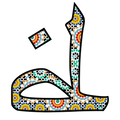WHAT YOU DIDN’T KNOW ABOUT MOROCCAN EMBROIDERY

Embroidery is an integral part of the Moroccan culture. Traditionally, the art of embroidery has been practiced by women in Morocco’s rural areas and it was done as a form of leisure to pass the time or for decoration on clothes, pillows, curtains and bed linens.
Moroccan society and it’s something that Moroccans are proud of. Embroidery is a traditional art rooted in popular Moroccan culture.
As bright and dominant as other crafts; Moroccan embroidery is an art passed down from generation to generation; from mother to daughter.
Merging modernity and tradition, embroidery is generally directed by those passionate about traditional sewing, in particular housewives.
WHAT IS THE MOROCCAN EMBROIDERY ART?

Moroccan embroidery is an art that is composed of a wide variety of stitches, designs and colors. Each region has its own style. The most famous one is the point of Fez or “Tarz al Fassi”, closely followed by the points of Meknes, Rabat and Salé.
Young women learn to embroider in six months. Finely executed parts take much longer to complete! The asset of the embroiderer is patience, an essential quality for those who want to go to the end of their work.
Due to its originality, Moroccan embroidery uses different materials; it charms with its aesthetics, its finish and its very varied patterns.
WHAT ARE THE MOST KNOWN TYPES OF MOROCCAN EMBROIDERY?
FEZ EMBROIDERY
Fez embroidery is a traditional handicraft from Fez in Morocco. It's one of the ancestral traditional crafts that have been practiced by Moroccan women for centuries. Embroidery is an art that the Fassi family cannot do without; the woman practices it either to embroider articles for herself or for her family, or even to sell them. Fassi embroidery is illustrated by its diversity and richness and it uses different techniques like silk thread interlacing, beadwork, and chenille (a kind of needlepoint) to create this embroidery work.
MEKNES EMBROIDERY
The embroidery of Meknes, Tarz Al Maknassi, is comparable in its technique and its decoration to that of Fez called Ghorza. She knew how to preserve the tradition of Amazigh know-how rich in colors while mastering a purely Fassi technique.
This is a double-sided embroidery, executed in horizontal, vertical and diagonal line stitch. This embroidery carried out on muslin or cotton supports, proceeds to a harmonious marriage of colors. It is usually made up of seven different colors: green, blue, orange, red, black, yellow and purple.
The decor is made up mainly of floral motifs mixed with geometric designs and stars.
RABAT EMBROIDERY
If Morocco is the land of amazing embroidery, Rabat is its capital. Rabat, the country's capital city, is located on the Atlantic Ocean coast and has a deep connection with embroidery. Rabat embroidery styles differ from that of Fes as Rabat is more westernized than Fes. Therefore, it is still influenced by traditional Moroccan design elements such as floral designs or geometric patterns. Rabat embroidery is mostly done on white cotton, and it tends to focus on one color embroidered in a floss silk.
SALÉ EMBROIDERY
The embroidery of Salé is divided into 2 categories: old embroidery and new embroidery.
The old embroidery is part of the counted thread technique. It uses the curly line stitch with no backsides, which makes it read only on the face. It is generally monochrome: dark blue or carmine red with a few exceptions of pieces delicately harmonized in two or even three tones such as those applied to the curtains and the fronts of mattresses trimmed in navy blue, red and pink. The decorative patterns of the ancient embroidery of Salé derive from the flora.
Salé's new embroidery is rather polychrome, plain on the face in basket weave and cross stitch, which gives simple vertical line stitches on the reverse. This embroidery is both arborescent and geometric in composition with some representative motifs of the hand, a symbol of protection against evil influences.
WALL EMBROIDERY
Wall embroidery has been around for centuries. It’s not only pretty on the wall, but it can also give you loads of creative satisfaction. There are several types of Moroccan wall embroidery. The traditional varieties include cross-stitch, needlepoint, and tatting. The stitches in wall embroidery are much thicker than those in ordinary embroidery. It is a unique way to decorate your home or give it that designer touch.










Leave a comment